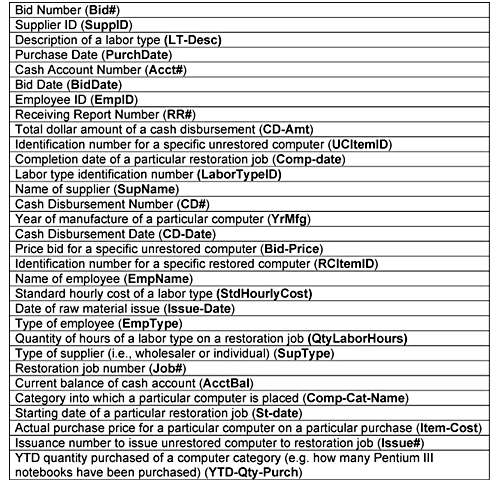Given the following narrative description for Seminole Computer Experts (SCE):
a. Create a business process level REA model in either grammar or diagram format, for the following business processes. Be sure to include all relevant entities, relationships, attributes, and cardinalities (minimum and maximum).
b. Convert your business process level model into a set of minimal relational database tables. Be sure to identify primary and foreign keys in the relational tables.
Seminole Computer Experts (SCE) is an enterprise that buys used computers for low prices, restores the computers, and then sells them at high prices. Each individual computer is assigned a unique identification number, and is categorized into a certain type (e.g. Notebook Pentium II, Notebook Pentium III, Desktop Pentium II, and so forth). Categories can be entered into the database before any computers in the categories are actually purchased. The unrestored computers are purchased from wholesalers as well as from individuals. One of SCE's purchasing agents submits a bid to the supplier that has listed a given computer (or computers) for sale. These unrestored computers are assigned unique identification numbers and are entered into the database upon making the bid. Sometimes it may be weeks before SCE is notified that its bid has been accepted or rejected. If the bid is accepted, one of SCE's inventory clerks will receive the item(s). Multiple bids accepted by the same supplier may be consolidated into one purchase. Bids are accepted in their entirety or not at all. For example, if SCE's bid on three different computers is accepted, SCE will receive all three of those items on the resulting purchase. If the supplier only accepts the bid as two of the three computers, that is considered a rejection of the bid. SCE may then submit a new bid that includes the two computers at the prices the supplier found acceptable. Slightly less than half of all SCE's bids are accepted. Suppliers and employees can be entered into the database before any transactions involving them occur.
SCE only purchases computers that need some work done on them, because that allows SCE to significantly increase their value by restoring them. Therefore when a computer is purchased, it is similar to raw material, although it is called unrestored computer inventory. When one or more restoration employees are available to begin restoring a computer, an inventory clerk issues the unrestored computer to a restoration job (and it never goes back into unrestored inventory). Each issuance and each job involve just one computer. The restoration of the computer is assigned a unique job number, and the start date and completion dates are recorded. Although SCE wants to keep track of each employee's position, SCE only wants to include one employee table in its database. SCE tracks which employees participate in each restoration job and also tracks what types of labor are used up; however, SCE does not track details of the specific labor operations that use up the labor. For each restoration job, one specific restoration employee serves as the restoration supervisor. The supervisor designation is not a permanent employee position; instead, any given employee may serve as the supervisor on one job and may serve as a subordinate on another restoration job. Each completed restoration job results in a computer that becomes part of "restored computer inventory."
In very rare instances, it is possible for the same computer to be bid on and purchased more than once. For example, SCE could buy a computer, sell it, and then a few months later buy it back again. However, SCE only buys computers that have needs for new restorations. Therefore, if SCE bids on and/or purchases the same computer again, the computer is assigned a different ID number than what it was assigned the previous time. SCE never returns computers to suppliers.
When payment is due for a purchase, SCE's cashier issues one check for payment in full for the item(s) on that purchase. Sometimes if multiple purchases have been made from the same supplier within a short period of time, SCE will pay for those purchases with just one check. One of SCE's managers is required to authorize all bids greater than $5,000 and is also required to sign all checks (including checks written for expenditures other than purchases of unrestored computers). Most of SCE's checks are written for purchases of unrestored computers. SCE needs to keep track of the managers' participation in these events as well as the participation of other employees in these events.
The following attributes are of interest to SCE and must be included in your solution. You may not add any attributes. You may abbreviate the attributes using the abbreviations given in bold in parentheses next to the attributes in the list.

Correct Answer:
Verified
View Answer
Unlock this answer now
Get Access to more Verified Answers free of charge
Q45: Which relationship in the conversion cycle contains
Q46: Which conversion cycle event represents the using
Q47: Which entities typically participate in a duality
Q48: What commitment events typically exist in the
Q49: If a person wants to know what
Q50: Is a company that manufactures paperclips and
Q51: Radio frequency ID tags (RFIDs) may be
Q52: Given the following narrative description for Lydia's
Q53: Create a "generic" REA business process level
Q55: Bentley Balloons is an enterprise that specializes
Unlock this Answer For Free Now!
View this answer and more for free by performing one of the following actions

Scan the QR code to install the App and get 2 free unlocks

Unlock quizzes for free by uploading documents